#Also irfan khan
Explore tagged Tumblr posts
Text
ICC Champions Trophy 2025: Fakhar Zaman, Saim Ayub Included in Pakistan Squad for CT Picked by Kamran Akmal

Champions Trophy 2025: Former cricketer Kamran Akmal has named his Pakistan squad for the Champions Trophy 2025. In a big surprise, Akmal named both the left-handed openers Fakhar Zaman and Saim Ayub in his squad.
Saim Ayub suffered an injury during Pakistan's Test series in South Africa and has been out of any professional cricket since that moment. The PCB decided to send Ayub to London for proper treatment, however, his chances of making it to the Champions Trophy are quite slim.
Meanwhile, Fakhar Zaman has been out of the team for a long time now. He was dropped after speaking against the board and was subsequently dropped from Pakistan's squad for the ODI series in Australia.
Read Also: PBKS vs GT Dream11 Prediction

Kamran Akmal includes Fakhar Zaman and Saim Ayub for the Champions Trophy
Kamran Akmal took to social media and picked his Pakistan squad of 15 players for the upcoming Champions Trophy. It is a strong squad but it depends on the fitness of a few players.
The squad doesn't have many surprises with the wicketkeeper-batter Mohammad Rizwan picked as the captain of the side. Fakhar Zaman, Saim Ayub, and Imam-ul-Haq are the three openers in the team. While Fakhar and Imam are fit, Ayub's fitness is a huge concern for the Men in Green.
The middle order looks solid with Babar Azam and Mohammad Rizwan likely to slot in at No. 3 and No. 4 respectively. Kamran Ghulam, who scored a magnificent hundred on his Test debut, has also found a place in the team, and so has the big-hitter Irfan Khan Niazi.
Salman Ali Agha, who is currently the vice-captain of the team, provides them with the required balance with his quality off-spin bowling. Salman has been one of the best performers for Pakistan across formats for the last few months.
Read Also: PBKS vs DC Dream11 Prediction

Strong Bowling Attack
The bowling line-up looks strong with Shaheen Afridi leading the pack. Shaheen, Naseem Shah, and Haris Rauf are the three frontline fast bowlers in the squad with Mohammad Hasnain and bowling allrounder Aamer Jamal being the reserve fast bowlers.
Left-arm chinaman bowler Sufiyan Muqeem and leg spinner Abrar Ahmed have been included as the two specialist spinners in the squad. The balance of the squad looks great but it all depends on Saim Ayub's fitness now.
Pakistan will begin its Champions Trophy campaign on February 19 against New Zealand in Karachi. The Men in Green will then travel to Dubai to face arch-rivals India in a highly anticipated clash. India and Pakistan are in Group A alongside Bangladesh and New Zealand.

Kamran Akmal's Pakistan squad for Champions Trophy 2025
Mohammad Rizwan (C) (wk), Fakhar Zaman, Saim Ayub, Babar Azam, Salman Ali Agha, Kamran Ghulam, Irfan Khan Niazi, Aamer Jamal, Shaheen Shah Afridi, Naseem Shah, Haris Rauf, Abrar Ahmed, Sufiyan Muqeem, Imam-ul-Haq, Mohammad Hasnain.
Read Also: Pakistan vs Afghanistan Dream11 Prediction CWC
2 notes
·
View notes
Text
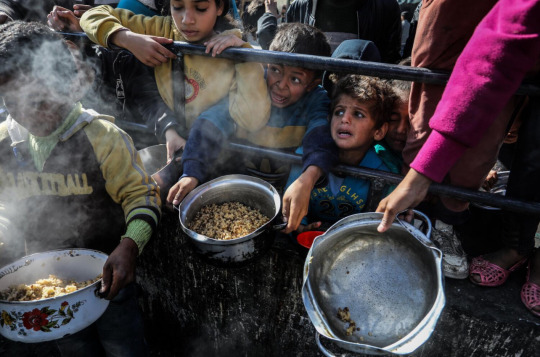
Displaced Palestinian children wait to receive food in Rafah, Gaza, on February 9, 2024. Photograph: Abed Rahim Khatib/Anadolu via Getty Images
I’m An American Doctor Who Went To Gaza. What I Saw Wasn’t War — It Was Annihilation
— February 16, 2024 | By Irfan Galaria | Los Angeles Times
late January, I left my home in Virginia, where I work as a plastic and reconstructive surgeon and joined a group of Physicians and Nurses traveling to Egypt with the humanitarian aid group MedGlobal to Volunteer in Gaza.
I have worked in other war zones. But what I witnessed during the next 10 days in Gaza was not war — it was annihilation. At least 28,000 Palestinians have been killed in Israel’s bombardment of Gaza. From Cairo, Egypt’s capital, we drove 12 hours east to the Rafah border. We passed miles of parked humanitarian aid trucks because they weren’t allowed into Gaza. Aside from my team and other envoy members from the United Nations and World Health Organization, there were very few others there.
Entering southern Gaza on Jan. 29, where many have fled from the north, felt like the first pages of a dystopian novel. Our ears were numb with the constant humming of what I was told were the surveillance drones that circled constantly. Our noses were consumed with the stench of 1 million displaced humans living in close proximity without adequate sanitation. Our eyes got lost in the sea of tents. We stayed at a guest house in Rafah. Our first night was cold, and many of us couldn’t sleep. We stood on the balcony listening to the bombs, and seeing the smoke rise from Khan Yunis.
As we approached the European Gaza Hospital the next day, there were rows of tents that lined and blocked the streets. Many Palestinians gravitated toward this and other hospitals hoping it would represent a sanctuary from the violence — they were wrong.
People also spilled into the hospital: living in hallways, stairwell corridors and even storage closets. The once-wide walkways designed by the European Union to accommodate the busy traffic of medical staff, stretchers and equipment were now reduced to a single-file passageway. On either side, blankets hung from the ceiling to cordon off small areas for entire families, offering a sliver of privacy. A hospital designed to accommodate about 300 patients was now struggling to care for more than 1,000 patients and hundreds more seeking refuge.
There were a limited number of local surgeons available. We were told that many had been killed or arrested, their whereabouts or even their existence unknown. Others were trapped in occupied areas in the north or nearby places where it was too risky to travel to the hospital. There was only one local plastic surgeon left and he covered the hospital 24/7. His home had been destroyed, so he lived in the hospital, and was able to stuff all of his personal possessions into two small hand bags. This narrative became all too common among the remaining staff at the hospital. This surgeon was lucky, because his wife and daughter were still alive, although almost everyone else working in the hospital was mourning the loss of their loved ones.
I began work immediately, performing 10 to 12 surgeries a day, working 14 to 16 hours at a time. The operating room would often shake from the incessant bombings, sometimes as frequent as every 30 seconds. We operated in unsterile settings that would’ve been unthinkable in the United States. We had limited access to critical medical equipment: We performed amputations of arms and legs daily, using a Gigli saw, a Civil War-era tool, essentially a segment of barbed wire. Many amputations could’ve been avoided if we’d had access to standard medical equipment. It was a struggle trying to care for all the injured within the constructs of a healthcare system that has utterly collapsed.
I listened to my patients as they whispered their stories to me, as I wheeled them into the operating room for surgery. The majority had been sleeping in their homes, when they were bombed. I couldn’t help thinking that the lucky ones died instantaneously, either by the force of the explosion or being buried in the rubble. The survivors faced hours of surgery and multiple trips to the operating room, all while mourning the loss of their children and spouses. Their bodies were filled with shrapnel that had to be surgically pulled out of their flesh, one piece at a time.
I stopped keeping track of how many new orphans I had operated on. After surgery they would be filed somewhere in the hospital, I’m unsure of who will take care of them or how they will survive. On one occasion, a handful of children, all about ages 5 to 8, were carried to the emergency room by their parents. All had single sniper shots to the head. These families were returning to their homes in Khan Yunis, about 2.5 miles away from the hospital, after Israeli tanks had withdrawn. But the snipers apparently stayed behind. None of these children survived.
On my last day, as I returned to the guest house where locals knew foreigners were staying, a young boy ran up and handed me a small gift. It was a rock from the beach, with an Arabic inscription written with a marker: “From Gaza, With Love, Despite the Pain.” As I stood on the balcony looking out at Rafah for the last time, we could hear the drones, bombings and bursts of machine-gun fire, but something was different this time: The sounds were louder, the explosions were closer.
This week, Israeli forces raided another large hospital in Gaza, and they’re planning a ground offensive in Rafah. I feel incredibly guilty that I was able to leave while millions are forced to endure the nightmare in Gaza. As an American, I think of our tax dollars paying for the weapons that likely injured my patients there. Already driven from their homes, these people have nowhere else to turn.
— Irfan Galaria is a Physician with a Plastic and Reconstructive Surgery Practice in Chantilly, Va.
#Los Angeles Times#Dr. Irfan Galaria#Gaza#Forever Palestine 🇵🇸#MedGlobal#Volunteer#Physicians#Nurses#Egypt 🇪🇬#War Crimes#Illegal Regime of the Zionist 🐖 🐷 🐖 Cunts
10 notes
·
View notes
Text
Pakistan Super League (PSL) 2025 All Teams and Squads

PSL 2025 Full Squad: The 10th edition of the Pakistan Super League (PSL) is to be played from 8 April to 19 May. Like the IPL, there are no auctions in PSL, but players are selected here through draft.
The PSL 2025 Player Draft took place in Lahore on January 13, 2025, in which all six franchises made their selections. A total of 116 players from 10 countries were selected in this draft.
Read Also: MUL vs QUE Dream11 Prediction PSL
The most surprising thing is that David Warner, Kane Williamson, Alzari Joseph and Daryl Mitchell were not sold in the IPL 2025 auction, but these high profile players are going to make their debut in this league. So let's know about all the teams and squads of PSL 2025.

PSL 2025 Team List
Islamabad United
Multan Sultans
Peshawar Zalmi
Quetta Gladiators
Karachi Kings
Lahore Qalandars
Read Also: MUL vs KAR Dream11 Prediction PSL

1. Islamabad United Squad for PSL 2025
Platinum: Matthew Short, Naseem Shah, Shadab Khan.
Diamond: Imad Wasim (Mentor), Azam Khan, Jason Holder.
Gold: Ben Dwarshuis, Salman Irshad, Salman Ali Agha (Brand Ambassador), Haider Ali.
Silver: Andris Goss, Colin Munro, Mohammad Nawaz, Rumman Raees.
Emerging: Hunain Shah, Saad Masood.
Supplementary: Riley Meredith, Rassi van der Dussen.

2. Multan Sultans Squad for PSL 2025
Platinum: Michael Bracewell, Mohammad Rizwan, Usama Mir.
Diamond: David Willey (Mentor),Iftikhar Ahm ed (Brand Ambassador), Usman Khan.
Gold: Chris Jordan, Kamran Ghulam, Mohammad Hasnain.
Silver: Aqif Javed, Gudakesh Moti, Josh Little, Faisal Akram, Tayyab Tahir.
Emerging: Ubaid Shah, Shahid Aziz.
Supplementary: Johnson Charles, Mohammad Aamir Barki, Shai Hope, Yasir Khan.
Read Also: MUL vs ISL Dream11 Prediction PSL

3. Peshawar Zalmi Squad for PSL 2025
Platinum: Babar Azam, Sam Ayub, Tom Kohler-Cadmore.
Diamond: Corbin Bosch, Mohammad Ali, Mohammad Haris.
Gold: Abdul Samad, Hussain Talat, Nahid Rana.
Silver: Arif Yaqoob, Najibullah Zadran, Max Bryant, Mehran Mumtaz, Sufyan Moqim (Brand Ambassador).
Emerging: Ali Raza, Maaz Sadaqat.
Supplementary: Ahmad Daniyal, Alzari Joseph.

4. Quetta Gladiators Squad for PSL 2025
Platinum: Faheem Ashraf, Finn Allen, Mark Chapman.
Diamond: Abrar Ahmed, Mohammad Amir (Mentor), Riley Russo.
Gold: Akeel Hosein, Saud Shakeel (Brand Ambassador), Mohammad Wasim Jr.
Silver: Haseebullah Khan, Khwaja Muhammad Nafe, Kyle Jamieson, Khurram Shahzad, Usman Tariq.
Emerging: Mohammad Zeeshan, Hasan Nawaz.
Supplementary: Danish Aziz, Kusal Mendis, Sean Abbott, Shoaib Malik.
Read Also: MUL vs LAQ Dream11 Prediction PSL

5. Karachi Kings Squad for PSL 2025
Platinum: Adam Milne, David Warner, Mohammad Abbas Afridi.
Diamond: Hasan Ali, James Vince, Khushdil Shah.
Gold: Aamir Jamal, Mohammad Irfan Khan, Shan Masood.
Silver: Arafat Minhas (Brand Ambassador), Liton Das, Mir Hamza, Tim Seifert, Zahid Mahmood.
Emerging: Fawad Ali, Riyyazullah.
Supplementary: Kane Williamson, Mohammad Nabi, Umair Bin Yousuf, Mirza Mamun.

6. Lahore Qalandars Squad for PSL 2025
Platinum: Daryl Mitchell, Fakhar Zaman, Shaheen Shah Afridi.
Diamond: Haris Rauf (Brand Ambassador), Kusal Perera, Sikandar Raza.
Gold: Abdullah Shafiq, Jahandad Khan, Zaman Khan.
Silver: Asif Afridi, Asif Ali, David Wiese, Mohammad Akhlaq, Rishad Hussain.
Emerging: Mohammad Azab, Momin Qamar.
Supplementary: Mohammad Naeem, Sam Billings, Salman Ali Mirza, Tom Curran.
Read Also: MUL vs ISL Dream11 Prediction PSL Final
0 notes
Note
Ive been looking through the indian squad in the 2000s and tbh none of the players there really stand out as omegas, secret or otherwise, to me?? like yuvraj singh, harbhajan singh, ashish nehra, zaheer khan, sreesanth-- all of them are certified alphas, totally playing into the stereotype of the hot-headed alpha male. anil kumble also gives major alpha vibes to me. venkatesh prasad and javagal srinath, the noted fast bowling combination of the 2000s-- im dithering a bit on whether they're alphas or betas. maybe more on the beta side tho, just to balance it out. virender sehwag is again an alpha, no doubt about that. irfan and yusuf pathan are alphas too ig, i think irfan even had a party boy image in his early days. vvs laxman is a beta. mohammad kaif and suresh raina can also be betas.
also i know why sachin tendulkar, rahul dravid and mahendra singh dhoni might feel like betas or even omegas in hiding, but idk to me i like these three specifically as alphas. because sachin, rahul and mahi are renowned for being gentlemen and being cool and calm. yk they're literally an antithesis to the traditional alpha stereotypes so the way vk subverts expectations that omegas must be quiet, demure and meek, the same way sachin, rahul and mahi can be instrumental towards proving that alphas don't necessarily have to always be violent, aggressive, dominant, and lewd with omegas. alphas can also be respectful, level-headed and conciliatory.
also, along the lines of what a previous anon said, sourav ganguly can be a secret omega! now tbh sourav gives me more alpha vibes, but i can see him being the indian equivalent of stu, trying his best to fit into the traditional alpha stereotypes of the times. and again since sourav was considered a great leader, a position that the world considers only alphas can be successful at, theres that breaking of expectations like with vk, for sourav, hands down our most aggressive and revolutionary captains, to be omega all along. and as someone who has family in kolkata (sourav's hometown), i can confirm that he really does come from a very moneyed family, so affording the indian equivalent of antarax would be no problem for him. also sourav x rahul dravid used to be a big ship back in the day, idk if you know! their teammates, even now, keep calling them "our mum and dad" and rahul publically said that "being captain and vice captain for so long, our relationship is like husband and wife at this point"'. 😭🤌🏻 they were practically the cookerson of their times. so rahul being the only one who knew sourav was omega all along and still supporting him no matter what ahhhh 😭😭😭
Aww that sourav/rahul is cute - I like that 🥰
I mean, we don’t have to have hiding omegas if it doesn’t work until later, it is just possible that there could be more of them. There are more hiding omegas; they’re everywhere 😂
Even when VK and Tim and others are out and proud, it still doesn’t mean all omegas are going to be comfortable with that. Even still some will take the hidden route, preferring to just play than play with the stresses that come along with being omega
0 notes
Link
[ad_1] File photo of Indian cricket team all-rounder Hardik Pandya© X (formerly Twitter)Former Indian cricket team all-rounder Irfan Pathan believes Afghanistan star Azmatullah Omarzai can be a potential replacement for Hardik Pandya in Gujarat Titans. Ahead of the Indian Premier League (IPL) 2024 Auction, GT face a tough challenge of replacing Hardik who rejoined Mumbai Indians in a sensational trade. Omarzai produced a brilliant all-round performance in the Cricket World Cup 2023 where he scored 353 runs in 9 matches and also took 9 wickets. Pathan said that the Afghanistan star is a good all-rounder option and with Rashid Khan already in their ranks, GT will be able to utilise Omarzai well."Looking at the Gujarat Titans, they are missing out on Hardik Pandya. Obviously, they are missing out on a leader and a guy who can actually do both bat and ball equally, really well. Who is there at the auction table?" Irfan said on Star Sports."I see Azmatullah Omarzai going to Gujarat Titans because he is a perfect fit. We have Rashid Khan there as well, who can actually get the best out of his countryman. Apart from an all-rounder, they require a proper fast bowler there. They need to go for that extra pace, and they have a good purse available," he added.Meanwhile, Irfan also stated that the five-time champions should go for pacer Harshal Patel, who has been released by Royal Challengers Bangalore."They have a lot of fast bowlers who can get injured regularly, guys like Deepak Chahar. They keep a lot of faith in Deepak Chahar but if he is not fit and available, they can be in a mess. So what they need - maybe a guy like Harshal Patel. Bangalore is not far from there, so just get Harshal Patel with a small ride of five hours, and just get him in CSK," Pathan said on Star Sports.Topics mentioned in this article [ad_2] Source link
0 notes
Text
The era of Indian Pacers from Kapil Dev to Jasprit Bumrah

It’s not wrong to say that there was a time when the Indian National Cricket team was struggling to find a single pacer in their squad! Who could bowl more than 150 KMPH against the top teams in the World? And today, the same Indian team has more than hundreds of pacers who can consistently bowl more than 150 KMPH. But you know, from where this journey started and who are the bowlers who have inspired every Indian to become the World’s best bowler for Men in Blue. Today we will know the era of Indian pacers from the Legendary Indian captain Kapil Dev to Jasprit Bumrah.
1. Kapil Dev (1978-1994): Kapil Dev is considered one of the greatest all-rounders in cricket history. Known for his explosive batting and swing bowling, he led India to its first-ever World Cup victory in 1983. Kapil Dev took 434 wickets in Test cricket and 253 in One Day Internationals (ODIs).
2. Javagal Srinath (1991-2003): In the 1990s and the beginning of the 2000s, Srinath was India's best fast bowler. Srinath, one of India's most effective fast bowlers, grabbed 236 wickets in Tests and 315 in ODIs.
3. Zaheer Khan (2000-2014): After the 2003 World Cup, the Indian team was having trouble finding a substitute for Javagal Srinath. India's success in the 2000s was greatly aided by a Mumbai-born left-arm bowler. He frequently confused batsmen with his variations because of his exceptional control of swing and seam movement. In tests, Zaheer collected 311 wickets, while in ODIs, 282 wickets.
Zaheer Khan hit the latest cricket news headlines when he yorked Steve Waugh, beating him for pace in his debut match against Australia.
4. Ishant Sharma (2007-present): The next big thing in Indian cricket, Ishant Sharma came in the top sports headline in the world when India toured Australia in 2008 , where Ishant Sharma bowled a dream spell to Ricky Ponting in the Perth Test.
In Test cricket, Ishant has taken more than 300 wickets and has contributed significantly to India's success in international matches. Ishant also holds the distinction of bowling the fastest ball ever by an Indian, measuring 152.6 km/h (94.8 mph) against Australia at Adelaide Oval on February 17, 2008. In the process, he surpassed teammate Ashish Nehra's 149.7 kph delivery to become the first Indian to bowl above 150 km/h.
5. Mohammed Shami (2013-present): Shami is the second-fastest Indian bowler to reach 50 ODI wickets in the process. He has been an essential part of India's fast bowling in the absence of Jasprit Bumrah, Md.Shami has taken over 200 wickets for India.
6. Jasprit Bumrah (2016-present): Jasprit Bumrah's extraordinary abilities and distinctive bowling action shocked the cricket world a long ago. In limited-overs cricket, his capacity to bowl at fast speeds and hit the blockhole in the death overs makes him an enormous threat to the Batsman.
Jasprit Bumrah came in the top sports news headline when he became the fastest Indian bowler to 50 and 100 wickets in ODIs and the fastest Indian to reach 50 wickets in T20Is.
These are just a few of the standout pacers who have represented India from the era of Kapil Dev to Jasprit Bumrah. However, the list is long with other notable names like Venkatesh Prasad, Ajit Agarkar, Irfan Pathan, and Bhuvneshwar Kumar, who have also contributed to India's fast bowling legacy during this period.
If you want to stay up to date, in getting the fastest sports news and information keep following SportsBuzz.
#latest cricket news#latest sports news#cricket prediction#sportsBuzz#cricket live score#latest sports news headlines#fantasy cricket tips
1 note
·
View note
Text
Present your research work on Advance Care Planning (ACP) at the 13NHPSUCG in Infront of the worldwide audience
14 ways to reach the ideal audience .
Although while producing content might be challenging in and of itself, there are instances when reaching the target audience presents an even greater challenge. A well-thought-out marketing strategy must always be combined with careful content creation; otherwise, your message is unlikely to reach the people you want to influence or attract to your company.
Ohio is experiencing a terrible environmental calamity, and you might not even be aware of it.
Former workers claim Twitter is caught in a nightmare recurrent code loop, and things might only get worse.
Greetings from UCG Committee, We invite you to register yourself for CME/CPD accredited 13th World Nursing, Healthcare Management, and Patient Safety Conference on November 15-18, 2023 in Los Angeles, USA. Register asap to get 10% discount. You can access all the conference sessions here: https://nursing.universeconferences.com/
If you're a health professional and you've an interest in Nursing, healthcare and patient safety register now to attend the CME/CPD accredited 13th World Nursing, Healthcare Management, and Patient Safety Conference on November 15-18, 2023 in Los Angeles, USA. #13NHPSUCG2023 will be covering improvements in Nursing, Healthcare management & Patient safety. Contact us: Email: [email protected] WhatsApp: +442033222718 Register here: https://nursing.universeconferences.com/registration/
BY THE EXECUTIVE BOARD OF FAST COMPANY
QUICK READ: 5 MIN
Although while producing content might be challenging in and of itself, there are instances when reaching the target audience presents an even greater challenge. A well-thought-out marketing strategy must always be combined with careful content creation; otherwise, your message is unlikely to reach the people you want to influence or attract to your company.
The Fast Company Executive Board members are aware that having a brilliant way with words is not enough to have a successful content strategy. 14 of them provide helpful suggestions for marketing teams below.
1. ASK INFLUENCERS FOR QUOTES.
Get other thought leaders in your industry to contribute a quote with their perspectives if you're writing an article, and then get their approval before it's published. After the item is published, they will share it with their networks, thus by incorporating them, you are "baking in" distribution. - Lensa, Gergo Vari
2. FOCUS ON BYLINED ARTICS AND GUEST POSTING.
Using a bylined article or guest posting strategy, you can introduce your concepts and thought leadership to other websites. When someone reads and appreciates your content on the website of an established trade newspaper, they are probably going to look for more of it, which will lead them right to your website. the idea grove's Scott Baradell
3. DISTRIBUTE CONTENT IN DIFFERENT WAYS, DEPENDING ON THE AUDIENCE.
Your audience will respond favourably to valuable content, and segmenting your content's release by audience type for blogs, social media, newsletters, and other platforms will boost interaction. Since the ultimate objective is to promote thought leadership, engaging your audience with true storytelling may frequently be one of the finest strategies to reinforce your brand and industry position. CLOUDSUFI's Irfan Khan
3. TIMING IS Crucial.
What matters most is not simply what you say, but also when you say it. When a consumer receives a good message at precisely the right time, it's not marketing; it's excellent customer service. Look for the crucial occasions in your consumers' lives. Because your audience will demand more of your message if you can elevate it to the level of excellent service. They'll even come looking for it. LiveArea, a Merkle Business, Barry Fiske
4. MONITOR YOUR OUTCOMES.
Follow it. Determine what is delivering you the outcomes that are important to you after publishing your material on a variety of channels and in a variety of formats. There might be a rise in the quantity of calls scheduled, more interest in a certain area of your organisation, or even more interest in you personally. Decide where the majority of the desired results are coming from and commit fully to that approach. This information could mean the difference between earning millions of dollars in revenue or failing to do so. - 6 Figure Recruiter Benjamin Nader
5. SUBHEADINGS AND HEADINGS MUST BE OPTIMIZED.
Many companies neglect to properly optimise the headlines and subheadings of their content. A catchy blog or post title will draw readers in addition to improving your search result ranking. Create concise, descriptive blog headlines that make it clear to the reader what the content is about using a headline analyzer. This easy action by itself can increase traffic without putting in a lot of work. WPBeginner Syed Balkhi.
Get ready with your poster. The UCG Committee is glad to encourage researchers to submit poster presentations at the 11th World Nursing, Healthcare Management, and Patient Safety Conference, which will be held in San Francisco, USA on November 15-17, 2022, and is CME/CPD approved. Only 2 slots left. Submit the poster here: https://nursing.universeconferences.com/submit-abstract/
How to Draw Global Attendance to Your Online Event
Virtual and online events are becoming common in the modern era. They allow companies to connect with a large, diverse audience across many countries and time zones. The same level of care must be taken in planning, publicising, and hosting a virtual event as it would in a physical one.
Make a worthwhile event to attend.
Think about what your potential overseas customer would like rather than what YOU want from the event (often leads and new business). Give them something worthwhile. Find out what their frequent problems are, think about what would make them ecstatic, find out what trends they should be aware of, etc.
Digital live scribing, for instance, is a fantastic method to involve your audience and provide them with something special. Illustrations are brought to life in real time by illustrators, creating a new level of engagement.
Do Some Research on Your Global Audience
It would be helpful for your event if you could determine the attendees' nationalities. Will they travel from all over the world? or mainly those from Western Europe? This matters since every culture has different perspectives on things depending on where they are from!
To avoid unpleasant shocks later on, you should gather demographic data on your audience. How varied the host's audience is has a big impact on the show. A global audience can be difficult to present to. Your ability to present well and steer clear of common blunders will be improved by cross-cultural communication training.
Make the signup page more efficien.
Making registration easy and appealing should be the two goals of your registration page. Everything from knowledge retention to traffic creation can benefit from visual material. Keep straightforward forms with the fewest fields possible. Reducing the number of hoops needed to register for an event has never been a mistake.
You can utilise event management software like Eventzilla, which automates the event registration process by developing engaging landing pages for attendees, managing attendance lists (and automatically syncing them), and producing embeddable widgets.
Greetings from UCG Committee, We invite you to register yourself for CME/CPD accredited 13th World Nursing, Healthcare Management, and Patient Safety Conference on November 15-18, 2023 in Los Angeles, USA. Register asap to get 10% discount. You can access all the conference sessions here: https://nursing.universeconferences.com/
If you're a health professional and you've an interest in Nursing, healthcare and patient safety register now to attend the CME/CPD accredited 13th World Nursing, Healthcare Management, and Patient Safety Conference on November 15-18, 2023 in Los Angeles, USA. #13NHPSUCG2023 will be covering improvements in Nursing, Healthcare management & Patient safety. Contact us: Email: [email protected] WhatsApp: +442033222718 Register here: https://nursing.universeconferences.com/registration/
0 notes
Text
Click to read sania mirza farewell party yuvraj singh saina nehwal irfan pathan dance to oo antava together with farah khan viral video jst
Sania Mirza farewell party: Six-time Grand Slam winner, India’s top tennis player Sania Mirza ended his illustrious journey on Sunday (March 5) by playing his last match at Lal Bahadur Tennis Stadium in Hyderabad. At the same time, the Indian tennis star also held a farewell party last night, attended by Mahesh Babu, AR Rahman, Namrata Shirodkar, Neha Dhupia, Huma Qureshi, Farah Khan, Yuvraj…
View On WordPress
0 notes
Note
https://open.spotify.com/track/4YIhJmihoXwjtbY4vsV9Nh?si=WdwLVgAzTXK1piZNKGDOhw&utm_source=copy-link
make of this one what u will i sadly don't listen to embarrassingly bad Hindi songs enough 😔😔😔😔
But this is such a legit good song. And the movie is such a great one too
2 notes
·
View notes
Video
tumblr
Thibaut + Irfane | 25th Jan 2019 @ Electric Brixton
#breakbot#irfane#thibaut berland#christopher irfane khan acito#ed banger#edm#ed banger house party#my videos#break of dawn had the prettier light show but it was also filled with narmy vocals from the people around me
8 notes
·
View notes
Text
ICC Champions Trophy 2025: Fakhar Zaman, Saim Ayub Included in Pakistan Squad for CT Picked by Kamran Akmal

Champions Trophy 2025: Former cricketer Kamran Akmal has named his Pakistan squad for the Champions Trophy 2025. In a big surprise, Akmal named both the left-handed openers Fakhar Zaman and Saim Ayub in his squad.
Saim Ayub suffered an injury during Pakistan's Test series in South Africa and has been out of any professional cricket since that moment. The PCB decided to send Ayub to London for proper treatment, however, his chances of making it to the Champions Trophy are quite slim.
Meanwhile, Fakhar Zaman has been out of the team for a long time now. He was dropped after speaking against the board and was subsequently dropped from Pakistan's squad for the ODI series in Australia.
Read Also: PBKS vs GT Dream11 Prediction
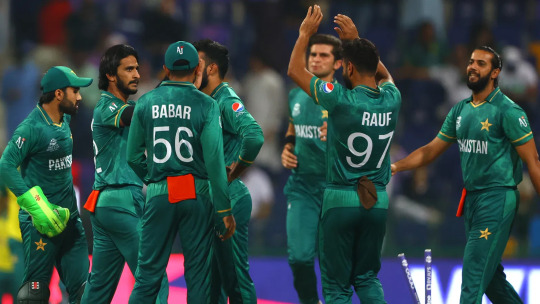
Kamran Akmal includes Fakhar Zaman and Saim Ayub for the Champions Trophy
Kamran Akmal took to social media and picked his Pakistan squad of 15 players for the upcoming Champions Trophy. It is a strong squad but it depends on the fitness of a few players.
The squad doesn't have many surprises with the wicketkeeper-batter Mohammad Rizwan picked as the captain of the side. Fakhar Zaman, Saim Ayub, and Imam-ul-Haq are the three openers in the team. While Fakhar and Imam are fit, Ayub's fitness is a huge concern for the Men in Green.
The middle order looks solid with Babar Azam and Mohammad Rizwan likely to slot in at No. 3 and No. 4 respectively. Kamran Ghulam, who scored a magnificent hundred on his Test debut, has also found a place in the team, and so has the big-hitter Irfan Khan Niazi.
Salman Ali Agha, who is currently the vice-captain of the team, provides them with the required balance with his quality off-spin bowling. Salman has been one of the best performers for Pakistan across formats for the last few months.
Read Also: PBKS vs DC Dream11 Prediction

Strong Bowling Attack
The bowling line-up looks strong with Shaheen Afridi leading the pack. Shaheen, Naseem Shah, and Haris Rauf are the three frontline fast bowlers in the squad with Mohammad Hasnain and bowling allrounder Aamer Jamal being the reserve fast bowlers.
Left-arm chinaman bowler Sufiyan Muqeem and leg spinner Abrar Ahmed have been included as the two specialist spinners in the squad. The balance of the squad looks great but it all depends on Saim Ayub's fitness now.
Pakistan will begin its Champions Trophy campaign on February 19 against New Zealand in Karachi. The Men in Green will then travel to Dubai to face arch-rivals India in a highly anticipated clash. India and Pakistan are in Group A alongside Bangladesh and New Zealand.
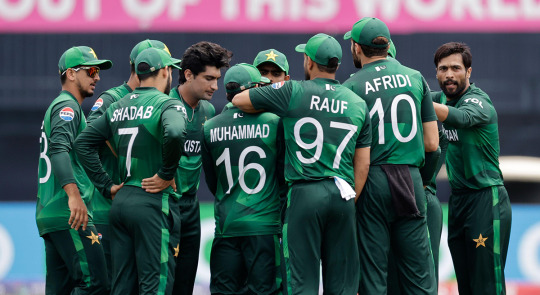
Kamran Akmal's Pakistan squad for Champions Trophy 2025
Mohammad Rizwan (C) (wk), Fakhar Zaman, Saim Ayub, Babar Azam, Salman Ali Agha, Kamran Ghulam, Irfan Khan Niazi, Aamer Jamal, Shaheen Shah Afridi, Naseem Shah, Haris Rauf, Abrar Ahmed, Sufiyan Muqeem, Imam-ul-Haq, Mohammad Hasnain.
Read Also: Pakistan vs Afghanistan Dream11 Prediction CWC
1 note
·
View note
Text
Qala Movie Review
In the Qala film, a young playback singer with the name is the leading character. The film story takes place in the early 1940s and 1930S. It is about how their sad past catches up with her as she is getting the hard-won success and makes her fall apart.
Qala Movie OTT Channel
Late Irfan Khan’s Son, Babil Khan, makes his acting in the movie. He has worked on a short film as a cameraman. The movie is a horror-thriller such as Bulbul. It was made by the same team. The OTT platform Netflix first talked about the project a year ago, and it took all the digital rights to the movie.
Qala Film Digital Rights
The horror movie Qala where the lead role is well-played by Tripti Dimri, whose performance in the movie Bulbul impressed both critics and viewers. Similar individuals who worked on Bulbul are doing the project, and that may debut directly on the Netflix platform. But the individuals who made the OTT channel have not said when it might come out yet.
Review
Karnesh Sharma’s Clean Slate Filmz is back with Anvitaa Dutt after 2020 Bulbul to continue the initiative of backing women telling women’s stories. The movie gets Tripti Dimri in the front seat with the solid support of debutant Babil Khan and Swastika Mukherjee, son of the Late Irfan Khan.
You will see a fictitious period drama about a playback singer. Qala is an unspoken path and unfamiliar in terms of relations. It goes beyond the obvious things to discover the underlying complexities of a mother-daughter relationship, a rare sight in Hindi movies. The latter has either villainized or overlooked the conflict for the gallery. Also, Qala dares to see the raw, even the ugly inside of seemingly normal relations, with a heart-aching longing and regret at the center.
2 notes
·
View notes
Text
One Year Later - What it’s like to die from Covid-19
“I wouldn’t wish it on my worst enemy”: Doctors describe what their sickest coronavirus patients endure.

Photograph: Healthcare workers prepare to prone a patient in the Covid-19 Intensive Care Unit (ICU) in Mission Hills, California. Ariana Drehsler/Bloomberg via Getty Images.
We’ve reached half a million deaths from the coronavirus in the US. But most of these deaths — and the grueling medical ordeals leading up to them — have remained largely hidden from view. The majority of terminally ill Covid-19 patients typically spend their last days or weeks isolated in ICUs to keep the virus from spreading.
“Most of what I’m seeing is behind closed curtains, and the general public isn’t seeing this side of it,” says Todd Rice, a critical care and pulmonology specialist at Vanderbilt University Medical Center. Even “families are only seeing a little bit of it,” he says. As a result, most of us have been “protected and sheltered from seeing the worst of this disease.”

Photograph: Health care workers prone a patient in the Covid-19 intensive care unit overflow area at Providence Holy Cross Medical Center in Mission Hills, California. Ariana Drehsler/Bloomberg/Getty Images.
So what have these 500,000 people endured as the infection took over and their bodies failed? The terrible details have been strikingly absent from most of our personal and national discussions about the virus. But if we have been thus far (perhaps somewhat willfully) blind to the excruciating ways Covid-19 takes lives, this milestone is an opportunity to open our eyes.

Photograph: A woman holds her husband’s hand as a nurse holds a phone displaying a mariachi band playing “La mano de Dios,” his favorite song, at St. Jude Medical Center in Fullerton, California. Irfan Khan/Los Angeles Times/Getty Images.
Patients struggling through low oxygen levels like this have told Kenneth Remy, an assistant professor of critical care medicine at Washington University School of Medicine in St. Louis, that it feels like a band across their chest or that their lungs are on fire. Or like a thousand bees stinging them inside their chest. Others might have thick secretions in their lungs that make it feel like they are trying to breathe through muck. Many people say it feels like they’re being smothered.
The agony of being critically ill with Covid-19 isn’t just borne by the body but also by the mind. “It doesn’t only put your lungs on fire or give you a horrible headache or make you feel miserable or make you breathe really fast,” Remy says. “It also wreaks havoc on your mental state.”

Photograph: Chaplain Kevin Deegan prays with a Covid-19 patient, as she speaks with family members remotely, at Providence Holy Cross Medical Center in Los Angeles. Mario Tama/Getty Images.
A significant proportion of people — somewhere between about 1 in 5 and 1 in 3 — who get very sick with Covid-19 also end up with kidney failure. To prevent this from killing them, they’re put on dialysis machines, which take blood out of the body and filter it before returning it to the body. This procedure can cause nausea, cramping, and chronic itching. Anyone getting dialysis will need two additional large catheters put into another major blood vessel.
But these aren’t all of the tubes critically ill Covid-19 patients need. They also have a central venous catheter to administer medication. This long tube usually gets inserted into a major vein in the clavicle or groin, then is pushed through the vein until it reaches the heart, where it will stay until that person recovers or dies. Another catheter, sometimes put in near the groin, will take the person’s blood for analysis.
Other catheters will be inserted into the urethra to drain urine (which is monitored closely) and the rectum to frequently evacuate their feces (which is especially important because Covid-19 often causes diarrhea). Additional IVs, such as for hydration and medications, will poke patients in smaller vessels as well. People this ill with Covid-19 will also have a tube put into their mouth or nose and down into their stomach, to deliver a nutritious slurry to prevent malnutrition.

Photograph: Funeral home transporter Reggie Elliott prepares a body at Maryland Cremation Services in Millersville, Maryland. Andrew Caballero-Reynolds/AFP/Getty Images.
Meilinh Thi, who specializes in critical care and pulmonology at the University of Nebraska Medical Center, has witnessed the same thing. “A lot of patients, regardless of age, have this sense of impending doom,” Thi says. Many have told her outright they felt like they were going to die. Eerily, “Everyone who has told me that has passed away,” she says.
Despite the palliative care and the possibility for family to now be present for a person’s actual death, doctors describe Covid-19 as a uniquely terrible way to die. “Covid is just so different,” Thi says. “I don’t think anything could be comparable to it. ... I don’t wish it on my worst enemy.”
By Katherine Harmon Courage (Vox)
#science#medicine#medblr#academia#infectious diseases#wear a mask#wash your hands#stopthespread#its not over yet#public health
82 notes
·
View notes
Text
12 Best Performances By Surekha Sikri That Prove She Is An Actor Par Excellence

A three-time National Film Award Winner, star of Indian Soap Operas, and Hindi theatre veteran, Surekha Sikri is undoubtedly one of the finest actors we have. Her latest performance in Badhaai ho has made us realize and made this very clear that the roles she opts for are actually written for her only. The way she does justice to each one of the roles is really remarkable. She is born on 19 April 1945 in New Delhi, British India. She belongs to Uttar Pradesh and she spent her childhood in Almora and Nainital. She also attended NSD. When I first heard about her, she is already in limelight due to her famous Dadisa’s role in the famous soap opera Balika Vadhu. She is always in limelight due to her hard-hitting characters and realistic acting. Some examples of her stellar performances are-
Surekha Sikri made her film debut in Kissa Kursi Ka (1978), with the role of Meera. Though her character wasn’t on the right side, she succeeded in making her impression on the audience.
Her supporting role as Rajo in Tamas (1988) stayed in people’s hearts forever. The movie is based on Bhisham Sahni’s novel, which made her win her First National Film Award for Best Supporting Actress. This shows the heart-wrenching effects on people during the partition.
Her performance in Salim Langde Pe Mat Ro (1989) was unbelievable because the role she played in the movie was way far from her age in real life. And she portrayed the character really well. The movie explores the effects of Hindutva extremism on minor communities. The movie won two national film awards.
Surekha’s role as Radha in a TV series Banegi Apni Baat (1993) remains one of Indian TV history’s most remarkable characters. The show was based on the class divide, gender differences.
The role of Fayyuzi in the first part of the Muslim Trilogy that is Mammo in 1994 whose director was Shyam Benegal, made Surekha Sikri win her second National Film Award. She was the protagonist’s legal guardian, who comes in an encounter with her long-lost sister, Mammo unexpectedly. Her role and character had a perfect balance of warmth and emotions.
In Kirdaar: Rehman Ke Joote, TV Series (1993-1995), Surekha Sikri managed really well to hold her performance and show her astonishing acting skills. Despite having Om Puri and Irfan Khan kind of stupendous actors in the series, she managed to get her part of fame. It was directed by Gulzar, which involves various short stories by Indian writers.
Surekha played the role of Ittan Bai in Sardari Begum (1996) was the second part of Shyam Benegal’s trilogy. Though the role was very brief, she still succeeded to make the place in the audience’s heart with her brilliant acting as always.
Hari Bhari (2000) was a collaboration of Surekha Sikri and Shyam Benegal to give life to his story of 5 women and their struggles with reproductive rights. Surekha has played the role of the eldest in the family, which shows the journey of life she has lived to the life of her granddaughter if the customs and traditions won’t change.
The final part of Benegal’s trilogy, made Surekha repeat her role as Fayyuzi in Zubeidaa (2001). With her performance in Zubeidaa, she proved again how finely she is seasoned with acting skills.
Surekha Sikri is an alumnus of NSD and she has continued acting throughout her career. Her act in the play Parindon Ki Mehfil was based on the 12th century Persian Poem written by Farududdin Attar, “Mantiq-Ut-Tayr”. Her acting was so brilliant in the play that people still remember her performance. Acting is in her blood. It's like she can act on anything at any time.
In Mr. and Mrs. Iyer (2002), she just had 2 scenes in the entire movie, but still, her anguish role was on point, and she was really appreciated for her fantastic acting skills.
Star Bestsellers’ Kabaad, TV Series (1999-2000), is one of the best tales of Star Bestsellers. It starred Surekha Sikri and Raghubir Yadav, which shows how a simple conversation between two people from completely different backgrounds curbs their loneliness. And undoubtedly, her performance was remarkable which made the simple story worth remembering for a lifetime.
No matter how small or big the role she played, she has always shined like a star and the best part about this is that she has started getting recognition and awards which she really deserves.
2 notes
·
View notes
Photo

USF contracts Rs 555 million with Telenor for mobile broadband services
Telenor has been given a contract for about Rs555 million by the Universal Service Fund (USF) to provide high-speed mobile broadband services in the districts of Nowshera, Mardan, Swabi, and Charsadda in Khyber-Pakhtunkhwa.
Syed Amin Ul Haque, Federal Minister for Information Technology and Telecommunications, and Pervez Khattak, Federal Minister for Defence, both attended the contract signing event at the USF Head Office.
The pact was signed by USF CEO Haaris Mahmood Chaudhary and Telenor Pakistan CEO Irfan Wahab Khan.
“We have not made claims and promises, but we have done what was never envisaged before at the Ministry of IT and Telecommunication,” Haque remarked.
“The fact is that in the past fiscal year, we contracted 25 projects totaling more than Rs31 billion for the provision of high-speed internet services and the installation of optical fiber cable in unserved and underserved regions of the nation. While the number of projects has been raised to 30 in the current fiscal year, the performance of all institutions under the Ministry of IT and Telecommunication in achieving the Digital Pakistan goal is becoming an example with each passing day.” He went on to say.
“Mobile operators provide networking and broadband services in cities, but in dispersed or poorly populated areas, making it impossible for them to operate profitably. In such situations, the Ministry of Information and Telecommunications, through USF, not only identifies such regions but also pays a subsidy covering 80% to 90% of the project costs.”
“We think that inhabitants of rural locations have the same right to high-speed mobile internet as city dwellers,” he continued.
Furthermore, he thanked the inhabitants of Charsadda, Swabi, Nowshera, and Mardan, stating that they would soon have the best mobile network and the quickest internet service to connect to the digital world. He also stated that the project will be finished on schedule.
Pervez Khattak stated that the inhabitants of Khyber-Pakhtunkhwa areas are no less capable than those of any other major metropolis. High-speed mobile broadband services in Charsadda, Swabi, Mardan, and Nowshera would benefit the youth of these districts in the field of education while also serving the country and the nation.
Earlier, in his welcoming address, Haaris Mahmood Chaudhary stated, “Without the consistent assistance of Federal Minister for IT and Telecommunication Syed Amin ul Haque, it would not have been feasible for the USF to launch 25 projects during the previous fiscal year.” As a consequence of the encouragement, we plan to start 30 new projects in the current fiscal year.”
“This project in Khyber-Pakhtunkhwa would assist 0.16 million people in 70 unserved mauzas, spanning an unserved area of 778 square kilometers in the districts of Nowshera, Mardan, Swabi, and Charsadda. I can promise you that the project will be done in 16 months.”
Published in Lahore Herald #lahoreherald #breakingnews #breaking
0 notes
Text
What Franchises might go for in PSL 6 Draft?

Pakistan Super League’s 6th edition is all set to take place from 20th February, 2021 with final to be played on 22nd March, 2021 at Gaddafi Stadium, Lahore. The tournament would require a strong team composition for reaching grand finale and as a part of making teams, all the 6 Franchises had given their retentions list to Pakistan Cricket Board. All the retentions were announced by PCB’s twitter handle today which is just a day before the actual draft takes place. The draft for making up full teams for PSL 6 is scheduled on 10th January, 2021 in Lahore which will help in shaping up the teams for the flagship event of PCB.
Keeping a look at the retentions, it looks like all the teams have opted for those players which they feel can help them in creating a winning combination. Every team had an option of retaining a maximum of 8 players. All the teams retained 8 players except Peshawar Zalmi, who retained only 5 players. Majority of the retained players are local players, whereas, out of 45 retained players only 10 are international players. An evenly balanced set of players has been retained which includes openers, middle order batsmen, fast bowlers, spinners and all-rounders. Let us have a look on each and every team individually which will help in identifying the possible picks for 2021.
Islamabad United
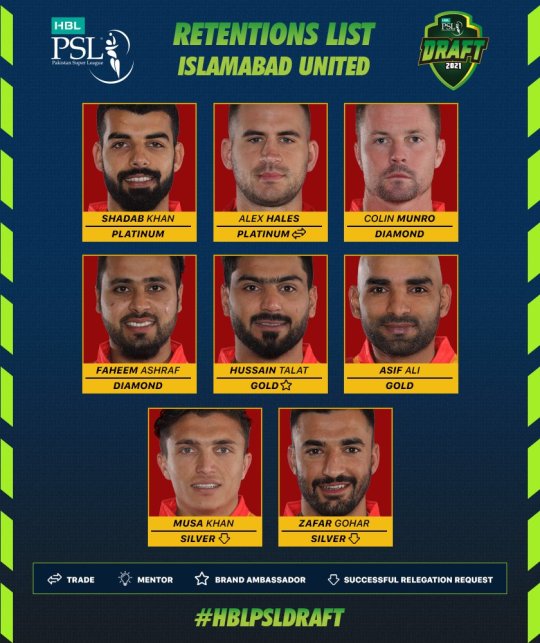
One of the most successful teams is Islamabad with 2 PSL titles to their name and they have retained 2 opening batsmen in which one has been traded with Karachi Kings. Other retentions include 3 all-rounders and 1 each middle-order batsman, fast bowler and spinner. Retained players include Alex Hales, Colin Munro, Asif Ali, Musa Khan, Zafar Gohar, Shadab Khan, Faheem Ashraf and Hussain Talat. Some of the major releases included Dale Steyn, Rumman Raees, Amad Butt, Phil Salt and Dawid Malan. But from the retentions, it seems that Islamabad’s management has gone for retaining performers and impact players only. With probably, the most balanced retentions, it seems like Islamabad will be eyeing on picking few batsmen of one whom can keep wickets as well along with strengthening their fast bowling unit. Another factor needs to keep in mind is that majority of England, New Zealand, Bangladesh and Australian players might not be available as they will be on their national duties.
Karachi Kings
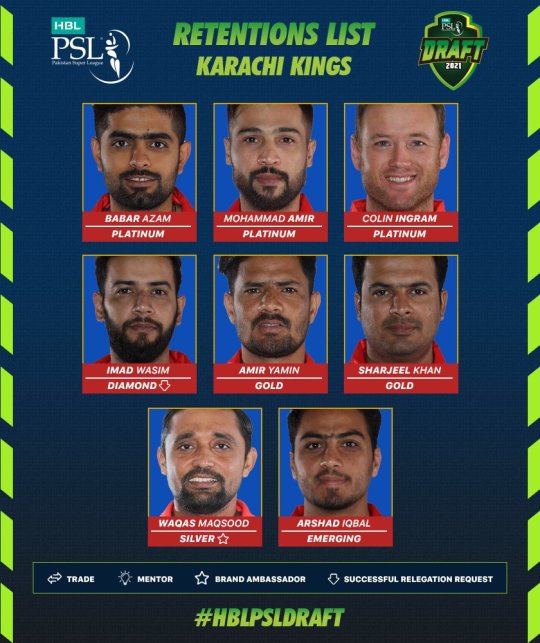
Defending champions have gone on to retain 8 players in which majority of local performing players are included. Retentions include the likes of Babar Azam, Sharjeel Khan, Imad Wasim, Muhammad Amir, Aamir Yamin, Waqas Maqsood, Arshad Iqbal and Colin Ingram. Karachi has opted for a majority of local players which seems that they will be relying more on local talent because international cricketing commitments for foreign players will make it tough. Looking at the retentions of KK, it seems they will be eyeing to select some all-rounders stuff including a wicket-keeping option. Karachi has gone for retaining majority of those players which will gurantee them good bowling stuff. Therefore, they will look out to pick middle-order batsmen including the likes of some hard hitting batsmen with spin bowling options. Some of the major miss-outs from Karachi’s retentions are Mohammad Rizwan, Chadwick Walton, Iftikhar Ahmed, Umer Khan, Cameron Delport, Umaid Asif and Chris Jordan.
Lahore Qalandars
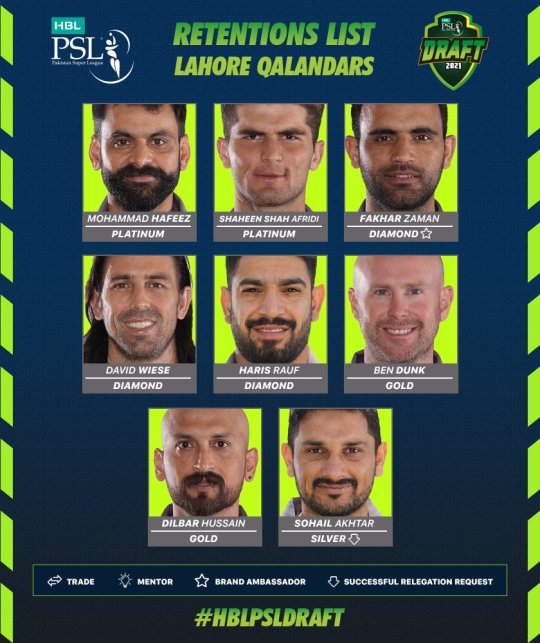
Finally, Lahore was able to turn the tables for themselves by finishing 3rd on the points table for the first time and peaked just at the right time of the tournament. Lahore was so close to winning the title but ended as runners up. The retentions list of Lahore included Mohammad Hafeez, Fakhar Zaman, Sohail Akhter, David Wiese, Dilbar Hussain, Shaheen Shah Afridi, Haris Rauf and Ben Dunk. All of these retentions were major performers in 2020 with each giving his performance at crucial stages of the tournament. However, Lahore didn’t retain one of their critical success factor, Samit Patel. It was earlier announced that Fakhar Zaman would not be retained but retentions list showed that Lahore has opted for retaining him. Key miss-outs were Usman Shinwar, Samit Patel and Chris Lynn. Lahore will be looking to pick some middle-order batsmen and spin options.
Multan Sultans
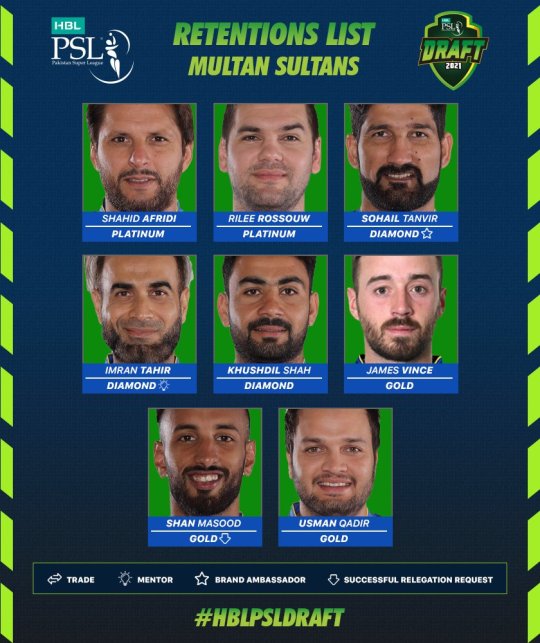
Multan had their best PSL last year but was unfortunately not able to win the trophy. The retention list of Multan included Shan Masood, James Vince, Rilee Rossouw, Sohail Tanvir, Shahid Afridi, Imran Tahir and Usman Qadir. Multan has also retained those players which makes the core of their team including middle order and top order batting along with one reliable T20 bowler in Sohail Tanvir and 3 leg spinners. From the team outlook, it seems that Usman Qadir, this time might get a longer run with Afridi and Imran Tahir at the eve of their playing careers. Key players that were not retained by Sultans included Moeen Ali, Zeeshan Ashraf, Ravi Bopara, Junaid Khan, Muhammad Irfan, Muhammad Ilyas and Rohail Nazir. Looking at the retentions, it seems like Multan will be looking to pick likes of fast bowlers and middle order batsmen as it self-sufficient in the spin department. However, like majority of teams, Multan will also be searching for a wicket keeping option in the drafts.
Peshawar Zalmi
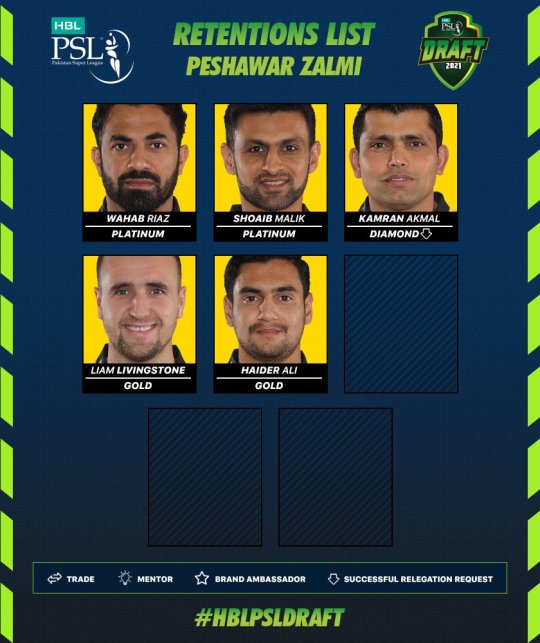
One of few teams who are eyeing a complete overhaul is Peshawar Zalmi. They have retained only 5 players as there was an option of retaining 8 but quite a selective list is being selected by them. Keeping in mind their turn in the draft, they seem to select diverse group of players as they have retained only 1 fast bowler, Wahab Riaz; 3 batsmen, Kamran Akmal, Liam Livingstone, Haider Ali and 1 all-round option in Shoaib Malik. It seems that majority of batting talent has been retained but some lower order batting options and complete bowling unit shall be picked in the draft. Peshawar had not performed that well in the last season and may be they want to completely overhaul their team composition as they have even gone on to release Hasan Ali, who had performed brilliantly with bat and ball in the domestic 4-day tournament. Some major outliers from Zalmi were Hammad Azam, Umar Amin, Tom Banton, Liam Dawson, Carlos Brathwaite, Imam ul Haq, Yasir Shah and Rahat Ali.
Quetta Gladiators
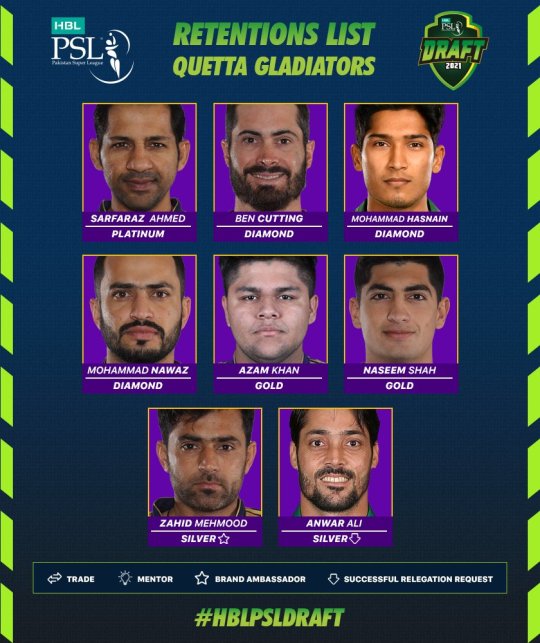
With most number of matches won in first four seasons of PSL, Quetta was named among top contenders as PSL returned home last year. However, Gladiators performed quite badly as they were 6th on the points table this year. Their combinations didn’t seem right and as a result of that, they have probably released all of their batting options. Retained players include Sarfraz Ahmed, Azam Khan, Ben Cutting, Muhammad Nawaz, Muhammad Hasnain, Anwar Ali, Naseem Shah and Zahid Mahmood. With decent performances in the domestic tournaments, Zahid Mahmood, unexpectedly has been retained. Some major players who were unable to see their names in the retention list of Quetta were Ahmed Shehzad, Ahsan Ali, Jason Roy, Fawad Ahmed, Tymal Mills, Sohail Khan and Khurram Manzoor. Keeping in mind the retentions list, core of the bowling unit has been retained, whereas, batting department’s overhaul will be done by picking appropriate players from the draft.
Let us all see that how teams shape up after the PSL draft on 10th January, 2021.
3 notes
·
View notes